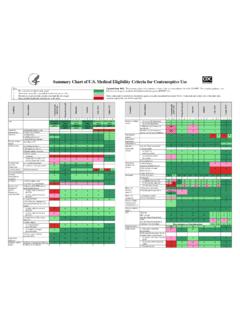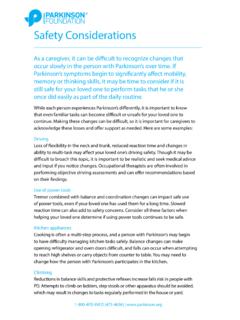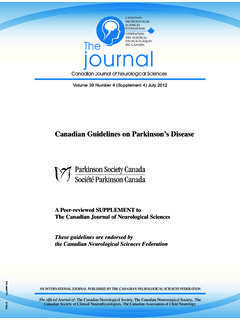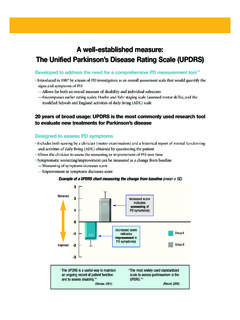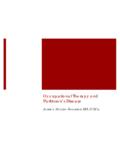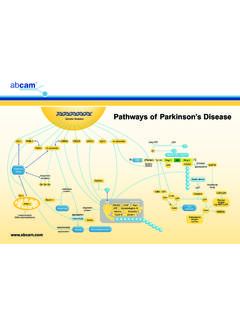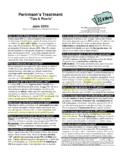Transcription of Unified Parkinson’s Disease Rating Scale - Medscape
1 TO POST-STROKE SPASTICITY MANAGEMENTTO RESTLESS LEG SYNDROME pssm TO DYSKINESIA MANAGEMENT dyskinesiaTO DYSKINESIA IN parkinson S DISEASEdpdTO RESTLESS LEG SYNDROME TO DYSKINESIA MANAGEMENT IN PDdyskinesiadyskinesiaTO POST-STROKE SPASTICITY MANAGEMENT pssmTO POST-STROKE SPASTICITY MANAGEMENT pssmTO DYSKINESIA IN parkinson S DISEASEdpdThank you very free to bill your time under a spasticity code #8302. Also, the billing code for the entire PSS project is need to get a graphic going for the online version of the Dyskinesia monograph. Let s try two versions. One that says Dyskinesia and one that says Dyskinesia Workbook, both ala the PD Workbook. The tag line should readThe Clinicians Guide to Management of Dyskinesia in PDBilling code for Dyskinesia is # parkinson s Disease Rating ScalePD WORKBOOK THE WE MOVE CLINICIANS GUIDE TO parkinson S Disease | Unified PD Rating Scale | WE MOVE 2006 23TO POST-STROKE SPASTICITY MANAGEMENTTO RESTLESS LEG SYNDROME pssm TO DYSKINESIA MANAGEMENT dyskinesiaTO DYSKINESIA IN parkinson S DISEASEdpdTO RESTLESS LEG SYNDROME TO DYSKINESIA MANAGEMENT IN PDdyskinesiadyskinesiaTO POST-STROKE SPASTICITY MANAGEMENT pssmTO POST-STROKE SPASTICITY MANAGEMENT pssmTO DYSKINESIA IN parkinson S DISEASEdpdThank you very free to bill your time under a spasticity code #8302.
2 Also, the billing code for the entire PSS project is need to get a graphic going for the online version of the Dyskinesia monograph. Let s try two versions. One that says Dyskinesia and one that says Dyskinesia Workbook, both ala the PD Workbook. The tag line should readThe Clinicians Guide to Management of Dyskinesia in PDBilling code for Dyskinesia is # Mentation, Behavior and Mood1. Intellectual Impairment0 = None. = Mild. Consistent forgetfulness with partial recollection of events and no other = Moderate memory loss, with disorientation and moderate difficulty handling complex problems. Mild but definite impairment of function at home with need of occasional = Severe memory loss with disorientation for time and often to place. Severe impairment in handling = Severe memory loss with orientation preserved to person only. Unable to make judgements or solve problems.
3 Requires much help with personal care. Cannot be left alone at Thought Disorder (Due to dementia or drug intoxication)0 = None. = Vivid = Benign hallucinations with insight = Occasional to frequent hallucinations or delusions; without insight; could interfere with daily = Persistent hallucinations, delusions, or florrid psychosis. Not able to care for Depression = P eriods of sadness or guilt greater than normal, never sustained for days or = Sustained depression ( week or more).3 = Sustained depression with vegetative symptoms (insomnia, anorexia, weight loss, loss of interest).4 = Sustained depression with vegetative symptoms and suicidal thoughts or Motivation/Initiative 0 = Normal. = Less assertive than usual; more = Loss of initiative or disinterest in elective (nonroutine) = Loss of initiative or disinterest in day to day (routine) = Withdrawn, complete loss of Activities of Daily Living (for both on and off )5.
4 Speech 0 = Normal. = Mildly affected. No difficulty being = Moderately affected. Sometimes asked to repeat = Severely affected. Frequently asked to repeat = Unintelligible most of the Salivation 0 = Normal. = Slight but definite excess of saliva in mouth; may have nighttime = Moderately excessive saliva; may have minimal = Marked excess of saliva with some = Marked drooling, requires constant tissue or Swallowing0 = Normal. = Rare = Occasional = Requires soft = Requires ng tube or gastrotomy S, Elton R, Members of the updrs Development Committee. In: Fahn S, Marsden CD, Calne DB, Goldstein M, eds. Recent Developments in parkinson s Disease , Vol 2. Florham Park, NJ. Macmillan Health Care Information , 53- 63, 2 POST-STROKE SPASTICITY MANAGEMENTTO RESTLESS LEG SYNDROME pssm TO DYSKINESIA MANAGEMENT dyskinesiaTO DYSKINESIA IN parkinson S DISEASEdpdTO RESTLESS LEG SYNDROME TO DYSKINESIA MANAGEMENT IN PDdyskinesiadyskinesiaTO POST-STROKE SPASTICITY MANAGEMENT pssmTO POST-STROKE SPASTICITY MANAGEMENT pssmTO DYSKINESIA IN parkinson S DISEASEdpdThank you very free to bill your time under a spasticity code #8302.
5 Also, the billing code for the entire PSS project is need to get a graphic going for the online version of the Dyskinesia monograph. Let s try two versions. One that says Dyskinesia and one that says Dyskinesia Workbook, both ala the PD Workbook. The tag line should readThe Clinicians Guide to Management of Dyskinesia in PDBilling code for Dyskinesia is # Handwriting0 = Normal. = Slightly slow or = Moderately slow or small; all words are = Severely affected; not all words are = The majority of words are not Cutting Food and Handling Utensils0 = Normal. = Somewhat slow and clumsy, but no help = Can cut most foods, although clumsy and slow; some help = Food must be cut by someone, but can still feed = Needs to be Dressing0 = Normal. = Somewhat slow, but no help = Occasional assistance with buttoning, getting arms in = Considerable help required, but can do some things = Hygiene0 = Normal.
6 = Somewhat slow, but no help = Needs help to shower or bathe; or very slow in hygienic = Requires assistance for washing, brushing teeth, combing hair, going to = Foley catheter or other mechanical Turning in Bed and Adjusting Bed Clothes0 = Normal. = Somewhat slow and clumsy, but no help = Can turn alone or adjust sheets, but with great = Can initiate, but not turn or adjust sheets = Falling (Unrelated to Freezing)0 = None. = Rare = Occasionally falls, less than once per = Falls an average of once = Falls more than once Freezing when Walking0 = None. = Rare freezing when walking; may have start = Occasional freezing when = Frequent freezing. Occasionally falls from = Frequent falls from Walking0 = Normal. = Mild difficulty. May not swing arms or may tend to drag = Moderate difficulty, but requires little or no = Severe disturbance of walking, requiring = Cannot walk at all, even with Tremor (Symptomatic complaint of tremor in any part of body.)
7 0 = Absent. = Slight and infrequently = Moderate; bothersome to = Severe; interferes with many = Marked; interferes with most Sensory Complaints Related to Parkinsonism0 = None. = Occasionally has numbness, tingling, or mild = Frequently has numbness, tingling, or aching; not = Frequent painful = Excruciating parkinson s Disease Rating Scale24 PD WORKBOOK THE WE MOVE CLINICIANS GUIDE TO parkinson S Disease | Unified PD Rating Scale | WE MOVE 2006 Fahn S, Elton R, Members of the updrs Development Committee. In: Fahn S, Marsden CD, Calne DB, Goldstein M, eds. Recent Developments in parkinson s Disease , Vol 2. Florham Park, NJ. Macmillan Health Care Information , 53- 63, 2 POST-STROKE SPASTICITY MANAGEMENTTO RESTLESS LEG SYNDROME pssm TO DYSKINESIA MANAGEMENT dyskinesiaTO DYSKINESIA IN parkinson S DISEASEdpdTO RESTLESS LEG SYNDROME TO DYSKINESIA MANAGEMENT IN PDdyskinesiadyskinesiaTO POST-STROKE SPASTICITY MANAGEMENT pssmTO POST-STROKE SPASTICITY MANAGEMENT pssmTO DYSKINESIA IN parkinson S DISEASEdpdThank you very free to bill your time under a spasticity code #8302.
8 Also, the billing code for the entire PSS project is need to get a graphic going for the online version of the Dyskinesia monograph. Let s try two versions. One that says Dyskinesia and one that says Dyskinesia Workbook, both ala the PD Workbook. The tag line should readThe Clinicians Guide to Management of Dyskinesia in PDBilling code for Dyskinesia is # Motor Examination18. Speech0 = Normal. = Slight loss of expression, diction and/or = Monotone, slurred but understandable; moderately = Marked impairment, difficult to = Facial Expression0 = Normal. = Minimal hypomimia, could be normal Poker Face. 2 = Slight but definitely abnormal diminution of facial expression3 = Moderate hypomimia; lips parted some of the = Masked or fixed facies with severe or complete loss of facial expression; lips parted /4 inch or Tremor at Rest (head, upper and lower extremities)0 = Absent.
9 = Slight and infrequently = Mild in amplitude and persistent. Or moderate in amplitude, but only intermittently = Moderate in amplitude and present most of the = Marked in amplitude and present most of the Action or Postural Tremor of Hands0 = Absent. = Slight; present with = Moderate in amplitude, present with = Moderate in amplitude with posture holding as well as = Marked in amplitude; interferes with Rigidity ( Judged on passive movement of major joints with patient relaxed in sitting position. Cogwheeling to be ignored.) 0 = Absent. = Slight or detectable only when activated by mirror or other = Mild to = Marked, but full range of motion easily = Severe, range of motion achieved with Finger Taps (Patient taps thumb with index finger in rapid succession.) 0 = Normal. = Mild slowing and/or reduction in = Moderately impaired. Definite and early fatiguing.
10 May have occasional arrests in = Severely impaired. Frequent hesitation in initiating movements or arrests in ongoing = Can barely perform the Hand Movements (Patient opens and closes hands in rapid succesion.) 0 = Normal. = Mild slowing and/or reduction in = Moderately impaired. Definite and early fatiguing. May have occasional arrests in = Severely impaired. Frequent hesitation in initiating movements or arrests in ongoing = Can barely perform the Rapid Alternating Movements of Hands (Pronation-supination movements of hands, vertically and horizontally, with as large an amplitude as possible, both hands simultaneously.) 0 = Normal. = Mild slowing and/or reduction in = Moderately impaired. Definite and early fatiguing. May have occasional arrests in = Severely impaired. Frequent hesitation in initiating movements or arrests in ongoing = Can barely perform the WORKBOOK THE WE MOVE CLINICIANS GUIDE TO parkinson S Disease | Unified PD Rating Scale | WE MOVE 2006 25 Unified parkinson s Disease Rating ScaleFahn S, Elton R, Members of the updrs Development Committee.




